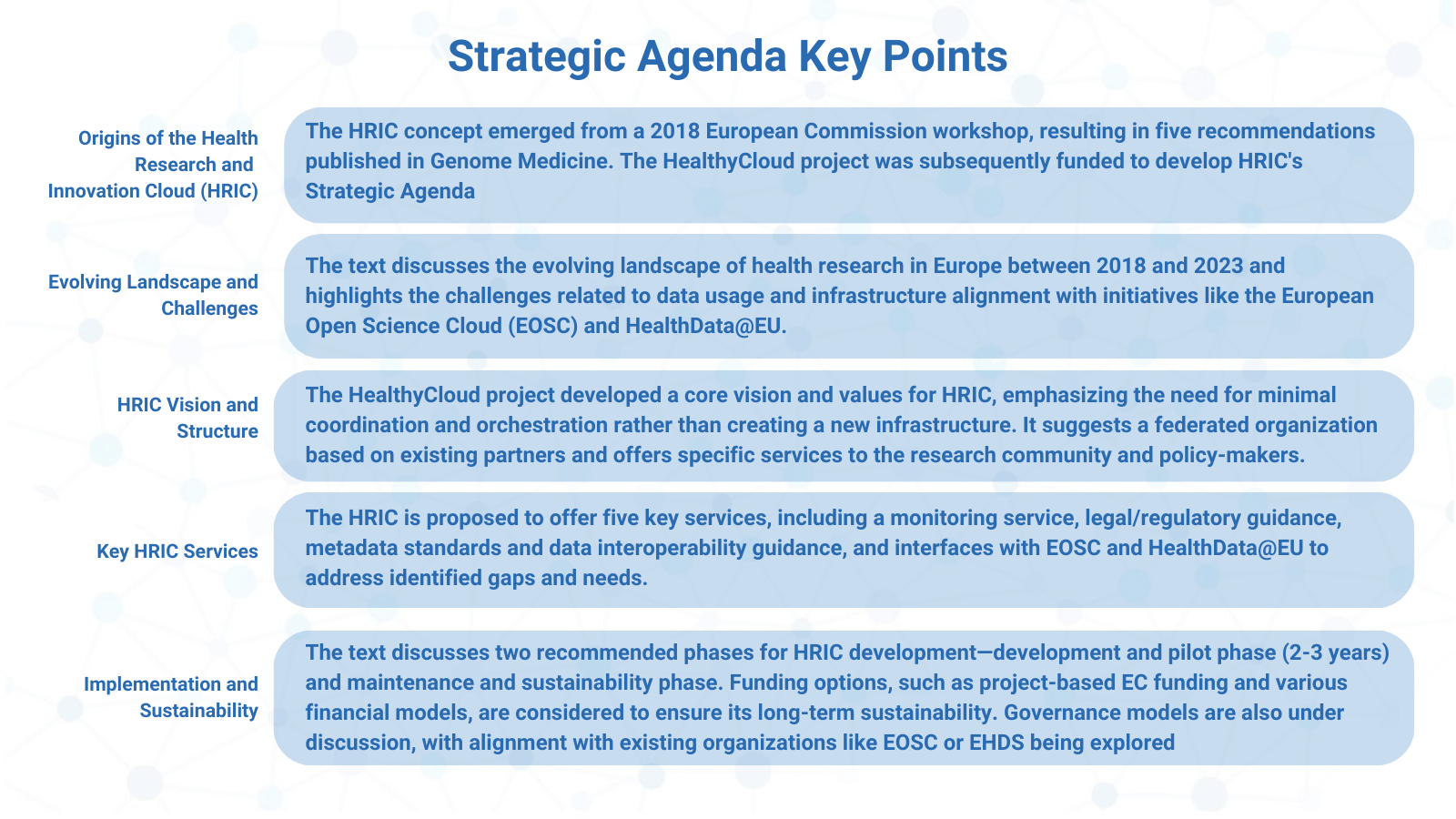THE STRATEGIC AGENDA

Strategic Agenda
Strategic Agenda
- Good practices for ethical & legal use of health data in EU
- Sustainable use of EU capabilities on computational systems

The Agenda in detail
Timeline
The idea of a European Health Research and Innovation Cloud (HRIC) for researchers, healthcare professionals, industry and policy makers across Europe was born during a workshop organised by the European Commission (EC) in 2018. As a result of this workshop, the HealthyCloud project was funded with the aim of developing the Strategic Agenda of the HRIC together with relevant stakeholders.
Due to the rapidly evolving research, regulatory and infrastructure framework relating to health research in Europe, even in the short time-period between 2018 and 2023, the work began by assessing the changing landscape, exploring the implications for the HRIC and the articulation of its relationship with existing large infrastructure initiatives like the European Open Science Cloud (EOSC) and HealthData@EU, the infrastructure for secondary use of health-related data of the European Health Data Space (EHDS). Gaps and uncertainties were identified as potential challenges for using and reusing data in health-related research and providing both rationale and focus areas for the HRIC.
Identified services for the HRIC
As a result of the intensive discussion within the HealthyCloud consortium and its working groups and following the recommendations given by stakeholder groups, five services were specified that the HRIC should provide:
- A monitoring service for health-related research
- A legal/regulatory guidance service
- A metadata standards and data interoperability guidance service
- A health research community interface service, with the EOSC
- A health research community interface service, with HealthData@EU
The HRIC in the European health data sharing landscape
The Strategic Agenda for the HRIC follows an agnostic approach, with possible options including affiliation to EOSC (“EOSC Health Research”) or a research part in the EHDS (“HealthData@EU for research”) or another construction. Given the ongoing infrastructure initiatives, it would be redundant to create a new infrastructure for the HRIC. Instead, a minimal coordination and orchestration body would be sufficient to minimise the administrative overload. Under this body the HRIC should have a federated organisation based on existing partners, such as European Research Infrastructures (RIs).
Possible governance models for the HRIC are highly dependent on the envisaged organisational structure, which has not been concluded yet. If the HRIC is affiliated to an existing organisation (e.g., EOSC), it must be integrated into the governance of that organisation. The possibility of creating a European Union (EU) Mission on “Health Research and Innovation” should also be explored.
HRIC implementation proposals
With respect to the implementation and sustainability, two sequential phases are recommended for the further development of the HRIC: the development and phase and, the maintenance and sustainability phase.
The development and pilot phase would provide the procedures and tools required for technical implementation of the proposed HRIC services and should be limited to 2-3 years, supported by EC project funding. Different types of financing should be carefully explored for long-term sustainability and some funding models discussed include “fee for services”, in kind contributions from existing RIs, funding through Member States contributions and EC funding by making use of the services an eligible category in EC projects. The maintenance and sustainability plan should be developed, approved, and implemented during the development and pilot phase and in collaboration with all relevant stakeholders (including key EOSC and EHDS actors) and potential funders.